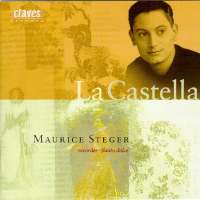|

Virtuosity without swank

PETER DALE explores the Italian baroque
 This
is a delightful concert of music, all of it Italian (Steger has made an
English Collection too, also from Claves Records) and spanning the hundred
years or so from 1650. Not all of the composers would be familiar except
to specialist listeners (friends of the recorder, as well as of the Italian
Baroque) but Corelli, Marcello and Vivaldi are among the company so we are
travelling on the highways as well as down the byways. This
is a delightful concert of music, all of it Italian (Steger has made an
English Collection too, also from Claves Records) and spanning the hundred
years or so from 1650. Not all of the composers would be familiar except
to specialist listeners (friends of the recorder, as well as of the Italian
Baroque) but Corelli, Marcello and Vivaldi are among the company so we are
travelling on the highways as well as down the byways.
These latter are probably the more interesting in fact, and certainly
no less musical. There's a Sonata in A Minor by Francesco Mancini which
is quite new to me but really good - by turns brilliant and reflective,
but always very intelligent and engaging in the variety of his textures.
[Listen - track 5, 01:20-02:20] Even more enjoyable
is a sonata - La Bernabea - by one Giovanni Antonio Pandolfi Mealli.
All we seem to know about the fellow is that he was at work 1660 and 1669.
Above his rather pedestrian bass lines he spins, tumbles, dances and sings
an astonishing variety of very musical moods. [Listen
- track 7, 00:00-01:06] Except that they lack words, every other nuance
of speech seems to be there. The whole piece is very impressive.
The Corelli Sonata is familiar as the tenth Violin Sonata of the Opus
5 set, but played here in a contemporary transcription for recorder. If
you didn't know the original you'd never guess that this wasn't it - so
idiomatic does it sound. [Listen - track 8, 01:10-02:10]
But you might begin to wonder how idiomatic, in that case, is his writing
for the violin. The solution to the problem is that Corelli's Concerti Grossi
are central to the string repertoire but not so much the sonatas. They are
central to the development of the sonata in the abstract, but less of string
sonatas in particular. In addition to these we are treated to sonatas by
Dario Castello and Marco Uccellini (and, of course, Marcello and Vivaldi).
Maurice Steger is a young Swiss musician. He plays Dutch, Swiss and Australian
instruments after English, and Italian models, and he plays them extremely
well. This is the flauto dolce indeed but never with that gawping
vibrato that too many flautists, having seen the error of their ways and
taken up the recorder, are apt to regale us with. Steger makes it sing alright
but he leaves the throbbing out. The articulation - some of it extremely
agile - is effortlessly accomplished. [Listen - track
18, 04:10-05:02] Or rather you can hear the gasping for breath
sometimes (these sound engineers are on the side of humans, as well as being
masters of their machines) but no sense of strain. The listener's turn to
gasp comes with Steger's cadenzas. They are models of virtuosity without
swank.
A very accomplished group of musicians are always there with Steger.
They are La Castella of the disc's title: harpsichord, chamber organ, theorbo
and cello. Steger's recorder is always to the fore and this seems a little
unfair because all these are really trio sonatas (ie. for four voices) and
all the players are very good, but the recorder, despite all the
efforts of Dolmetsch, Bruggen, Petri et al still needs to be exposed
for a lot of people to recognise what a beautiful and varied palette of
sound it can achieve when it is played very, very well, so I won't complain
for long. With people like Steger and La Castella (and our own Palladian
Ensemble) playing so very, very well, both the recorder and this still rather
specialised repertoire are going to gain the place in our affection and
admiration that they so richly both deserve.
Copyright © 5 March 2000 Peter Dale,
Danbury, Essex, UK
 INFORMATION - CLAVES CD 50-9809
PURCHASE FROM AMAZON
PURCHASE FROM CROTCHET
<< Music &
Vision homepage Goldmark chamber music >>
INFORMATION - CLAVES CD 50-9809
PURCHASE FROM AMAZON
PURCHASE FROM CROTCHET
<< Music &
Vision homepage Goldmark chamber music >>
 |
To listen to the aural illustrations in this review,
you may need to download RealNetworks' realplayer G2. |
|